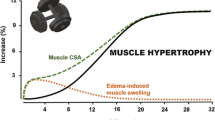Abstract
We measured ATP, phosphocreatine (PCr), inorganic phosphate (Pi), and the intracellular pH in rat hindlimb muscles during submaximal isometric exercise with various O2 deliveries using31P nuclear magnetic resonance spectroscopy (31P NMR) to evaluate changes in energy metabolism in relation to O2 availability. Delivery of O2 to muscles was altered by controlling the fractional concentration of inspired oxygen (F IO2) at 0.50, 0.28, 0.21, 0.11 and 0.08 with monitoring partial pressure of oxygen and carbon dioxide, and bicarbonate at the femoral artery. The steady-state ratio of PCr : (PCr + Pi) during exercise decreased as a function ofF IO2 even at 0.21. Significant acidification of the intracellular pH during exercise occurred at 0.08F IO2. Change in the PCr : (PCr + Pi) ratio demonstrated that the oxidative capacity, i.e. the maximal rate of the oxidative phosphorylation reaction, in muscle was not limited by O2 delivery at 0.50F IO2, but was significantly limited at 0.21F IO2 or below. Change in the intracellular pH at 0.08F IO2 could be interpreted as an increase in lactate, suggesting activation of glycolysis. Correlation between the PCr : (PCr + Pi) ratio and the intracellular pH revealed the existence of a critical PCr : (PCr + Pi) ratio and pH for glycolysis activation at around 0.4 and 6.7, respectively.
Similar content being viewed by others
References
Arthur PG, Hogan MC, Bebout DE, Wagner PD, Hochachka PW (1992) Modeling the effects of hypoxia on ATP turnover in exercising muscle. J Appl Physiol 73:737–742
Bolas NM, Rajagopalan B, Mitsumori F, Radda GK (1988) Metabolic changes during experimental cerebral ischemia in hyperglycemic rats, observed by31P and1H magnetic resonance spectroscopy. Strocke 19:608–614
Chance B, Leigh JS, Clark BJ, Jr, Maris J, Kent J, Nioka S, Smith D (1985) Control of oxidative metabolism and oxygen delivery in human skeletal muscle: a steady-state analysis of the work/energy cost transfer function. Proc Natl Acad Sci 82:8384–8388
Fitts RH, Holloszy JO (1976) Lactate and contractile force in frog muscle during development of fatigue and recovery. Am J Physiol 231:430–133
Gadian DG, Radda GK, Brown TR, Chance EM, Dawson MJ, Wilkie DR (1981) The activity of creatine kinase in frog skeletal muscle studied by saturation-transfer nuclear magnetic resonance. Biochem J 194:215–228
Hochachka PW, Matheson GO (1992) Regulating ATP turnover rates over broad dynamic work ranges in skeletal muscles. J Appl Physiol 73:1697–1703
Hochachka PW, Stanley, C, Matheson GO, McKenzie DC, Allen PS, Parkhouse WS (1991) Metabolic and work efficiencies during exercise in Andean natives. J Appl Physiol 70:1720–1730
Hogan MC, Arthur PG, Bebout DE, Hochachka PW, Wagner PD (1992) Role of O2 in regulating tissue respiration in dog muscle working in situ. J Appl Physiol 73:728–736
Idström JP, Subramanian VH, Chance B, Schersten T, Bylund-Fellenius AC (1985) Oxygen dependence of energy metabolism in contracting and recovering rat skeletal muscle. Am J Physiol 248: H40-H48
Katz A, Sahlin K (1987) Effect of decreased oxygen availability on NADH and lactate contents in human skeletal muscle during exercise. Acta Physiol Scand 131:119–127
Katz A, Sahlin K (1988) Regulation of lactic acid production during exercise. J Appl Physiol 65:509–518
Kuno S, Akisada M, Mitsumori F (1992) Phosphorus-31 nuclear magnetic resonance study on the effects of endurance training in rat skeletal muscle. Eur J Appl Physiol 65:197–201
Matheson GO, Allen PS, Ellinger DC, Haustock CC, Gheorghiu D, McKenzie DC, Stanley C, Parkhouse WS, Hochachka PW (1991) Skeletal muscle metabolism and work capacity: a31P-NMR study of Andean natives and lowlanders. J Appl Physiol 70:1963–1976
Smith DS, Chance B, Subramanian HV, Butler S, Katzenberg M (1990) Oxidative phosphorylation system during steadystate hypoxia in the dog brain. J Appl Physiol 68: 2527–2535
Pan JW, Hamm JR, Hetherington HP, Rothman DL, Shulman RG (1991) Correlation of lactate and pH in human skeletal muscle after exercise by1H NMR. Mag Reason Med 20:57–65
Sullivan MJ, Saltin B, Negro-Vilar R, Duscha BD, Charles HC (1994) Skeletal muscle pH assessed by biochemical and31P-MRS methods during exercise and recovery in men. J Appl Physiol 77:2194–2200
Systrom DM, Kanarek DJ, Kohler SJ, Kazemi H (1990)31P nuclear magnetic resonance spectroscopy study of the anaerobic threshold in humans. J Appl Physiol 68:2060–2066
Taylor DJ, Bore PJ, Styles P, Gadian DG, Radda GK (1983) Bioenergetics of intact human muscle — a31P nuclear magnetic resonance study. Mol Biol Med 1:77–94
Ugurbil K, Petein M, Maidan R, Michurski S, From AHL (1986) Measurement of an individual rate constant in the presence of multiple exchanges: application to myocardial creatine kinase reaction. Biochemistry 25:100–107
Wilson DF, Erecinska M, Drown C, Silver IA (1979) The oxygen dependence of cellular energy metabolism. Arch Biochem Biophys 195:485–493
Author information
Authors and Affiliations
Rights and permissions
About this article
Cite this article
Sunoo, S., Asano, K. & Mitsumori, F. 31P nuclear magnetic resonance study on changes in phosphocreatine and the intracellular pH in rat skeletal muscle during exercise at various inspired oxygen contents. Europ. J. Appl. Physiol. 74, 305–310 (1996). https://doi.org/10.1007/BF02226925
Accepted:
Issue Date:
DOI: https://doi.org/10.1007/BF02226925




